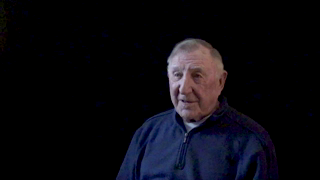7:36 | After his harrowing escape from the Philippines, Lyle Bercier was lucky to remain ashore in Sydney for two years. He was ambitious, though, and returned stateside to get a new ship. After cruising the Atlantic, he headed to the Pacific, where he participated in the bombardment of Iwo Jima and Okinawa. (This interview made possible with the support of COL ROBERT W. RUST, USMCR (ret.) in honor of LtGen Lawrence Snowden & LtGen George Christmas.)
Keywords : Lyle Bercier USS Quail (AM-15) Sydney Australia Washington DC ammunition depot cruiser Atlantic Pearl Harbor bombardment Iwo Jima Okinawa Kamikaze 5 inch gun atomic bomb

Lyle Bercier left a North Dakota Farm to join the Navy in 1940. Assigned to the Pacific Fleet in the Phillipines, his base was destroyed by Japanese air power the day after the Pearl Harbor attack. The remaining US ships moved to the mouth of Manila Bay after ground forces took the city. (This interview made possible with the support of COL ROBERT W. RUST, USMCR (ret.) in honor of LtGen Lawrence Snowden & LtGen George Christmas.)
The crew of the USS Quail was under constant air attack on Corregidor after the Philippines fell to the Japanese. Lyle Bercier describes the miserable days spent hiding in tunnels and the night missions to clear mines. (This interview made possible with the support of COL ROBERT W. RUST, USMCR (ret.) in honor of LtGen Lawrence Snowden & LtGen George Christmas.)
When the Philippines were surrendered to the Japanese, 18 men from the USS Quail decided to try and escape in a motor launch. Lyle Bercier details the beginning of their harrowing voyage south. They almost didn't make it out of Manila Bay. (This interview made possible with the support of COL ROBERT W. RUST, USMCR (ret.) in honor of LtGen Lawrence Snowden & LtGen George Christmas.)
During their escape from the Philippines, the men of the USS Quail faced a harrowing voyage on the open sea in their tiny motor launch. Their skipper was highly capable, even devising a homemade sextant. The sun and salt water caused painful blisters on young Lyle Bercier. They were twenty days out and headed for safety in Australia. (This interview made possible with the support of COL ROBERT W. RUST, USMCR (ret.) in honor of LtGen Lawrence Snowden & LtGen George Christmas.)
After 31 days on the open sea in a small boat, 18 men from the USS Quail finally reached safety in Australia. They had scuttled their ship and fled rather than become POW's. But in Australia, their story was not believed and it took some time before they were treated as the heroes they were, especially their skipper, John Morrill. (This interview made possible with the support of COL ROBERT W. RUST, USMCR (ret.) in honor of LtGen Lawrence Snowden & LtGen George Christmas.)
Lyle Bercier came home to North Dakota, but he was determined to make a career of the Navy. After a short return to the Philippines, he returned to the states to instruct aviators in gunnery. He had one last posting to a destroyer before disability forced him to retire. He found a job with the Navy's Bureau of Ordnance, though, and continued to serve in a different way. (This interview made possible with the support of COL ROBERT W. RUST, USMCR (ret.) in honor of LtGen Lawrence Snowden & LtGen George Christmas.)
As a 20 year old sailor, Lyle Bercier had survived an adventure in a small boat on the open sea, when men from the USS Quail fled the Philippines rather than surrender. Safely ashore in Australia, the Navy tested his mettle in different ways. (This interview made possible with the support of COL ROBERT W. RUST, USMCR (ret.) in honor of LtGen Lawrence Snowden & LtGen George Christmas.)